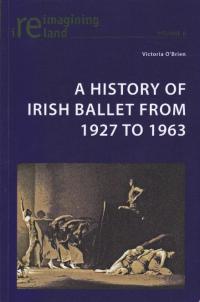A history of Irish ballet from 1927 to 1963
Published in 20th-century / Contemporary History, Issue 4 (July/August 2012), Reviews, Volume 20
A history of Irish ballet from 1927 to 1963
Victoria O’Brien
(Peter Lang, £32/€38)
ISBN 13 9783039118731
Victoria O’Brien’s book provides much-needed insight into the development of ballet in Dublin in the middle of the last century, presenting a most interesting first survey of the activities and achievements of the main groups operating there, studying them in four chapters. The surviving records of these schools or companies were scattered and fragmentary; without the writer’s extensive searches, much might have been lost forever.The Abbey Theatre School of Ballet (1927–33) was founded by Ninette de Valois at the invitation of W.B. Yeats. She directed the school for six years, spending in all about seven weeks per year in Dublin, overseeing teaching and rehearsals for the fourteen distinguished dance performances for which she choreographed new works and in which she danced. When she ended the experiment, the ‘architect of Irish ballet’ (p. 32) had trained a nucleus of young Irish dancers, teachers and choreographers. It continued until 1958 as a private school, no longer attached to the theatre, run by de Valois student Muriel Kelly. Sara Payne, whom de Valois had brought over to teach, opened a Dublin school and company in 1936, staging eight performances between 1937 and 1942 with innovative ballets of her own, in which she developed a new type of dance, adopting elements of traditional Irish dance. She left Ireland in 1946. Cepta Cullen, an Irish student of de Valois, opened her Irish Ballet Club in 1939, staging fourteen performances during the five years in which it operated. She too used Irish themes for many of her ballets, and collaborated with distinguished writers, artists and musicians.The final chapter deals with Patricia Ryan’s National Ballet School (1956–63), National Ballet Company (1959–63) and the fifteen performances given during its eight years. Like her predecessors, Ryan choreographed ballets on Irish themes and cooperated with Irish musicians and poets; in 1962 she organised a ballet week with Russian principals, in that year too registering the company as professional. In 1963 National Ballet was forced by its funder, the Arts Council of Ireland, to merge with the Irish Theatre Ballet, the Cork-based professional company. The Arts Council ceased funding in 1964 after one joint season. The papers of the composer A.J. Potter, one of National Ballet’s directors who collaborated with Ryan in three ballets, were not consulted: they cast much light on the company and the reasons for its closing. De Valois, Payne, Cullen and Ryan all left Ireland; their records have not survived. O’Brien has reconstructed their activities on the basis of documents found in the Dublin theatre archives, newspaper archives, personal collections of dancers involved and interviews with them. The reasons for the company closures have not been ascertained.It is a pity that there is no sketch of the historical and social context in which work for ballet was undertaken during this period: that would greatly facilitate an understanding of the enormous difficulties facing those active in the field and provide a background against which to measure their remarkable achievements. O’Brien’s book is a history of ballet in Dublin, not of ballet in Ireland. Two of the main companies operating at that time have been omitted: the Cork Ballet Company (1947–93) and Ireland’s first professional ballet company, Irish Theatre Ballet (1959–64). There is no chapter on Joan Denise Moriarty, who founded these companies and created well over a hundred ballets during her career. Irish Theatre Ballet toured Ireland, north and south, in two annual seasons, giving some 500 performances between 1959 and 1964. Marie Rambert and Alicia Markova were the company’s patrons; the distinguished dancer and choreographer Stanley Judson was the first ballet master; 24 new ballets were created for the company. Moriarty, the Cork Ballet Company (Ireland’s longest-lasting amateur company) and Irish Theatre Ballet constitute central elements of the history of ballet in Ireland.While Moriarty’s 25 years of work for dance during the period in question are ignored, her competence and, indeed, integrity are called into question. She is referred to in the sections of the book dealing with the impact of the Dublin groups on the subsequent development of ballet in Ireland. She is said to have derived her concept of Irish ballet from them (pp 70, 112), to have copied five of their ballets ‘to a large extent without accrediting the original choreographers’ (pp 148, 150) and to have facilitated their being forgotten so as to enhance her own reputation (pp 147, 149). The evidence offered for these charges is the mere titles of Moriarty’s ballets, and one extract from a programme booklet. The tracing of influences of one artist on another is, of course, a duty of the chronicler, but before valid conclusions can be drawn, a study has to be undertaken of the life and work of the person perhaps influenced. None of these charges withstand scrutiny. (See my longer review at http://www.corkcitylibraries.ie/music/joandenisemoriarty/.)The history of ballet in Ireland during this period has yet to be written, but the task will have been made very much easier by the study of 36 years of ballet in Dublin undertaken by Victoria O’Brien. HI
Ruth Fleischmann has recently retired as lecturer and Dean of Studies in the English Department, University of Bielefeld.
















